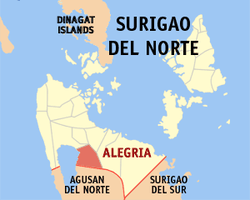Alegria, Surigao del Norte
| Alegria | ||
|---|---|---|
| Municipality | ||
| Municipality of Alegria | ||
| ||
 Map of Surigao del Norte with Alegria highlighted | ||
.svg.png) Alegria Location within the Philippines | ||
| Coordinates: 9°28′01″N 125°34′38″E / 9.4669°N 125.5772°ECoordinates: 9°28′01″N 125°34′38″E / 9.4669°N 125.5772°E | ||
| Country |
| |
| Region | Caraga (Region XIII) | |
| Province | Surigao del Norte | |
| District | 2nd District | |
| Barangays | 12 (see Barangays) | |
| Government [1] | ||
| • Type | Sangguniang Bayan | |
| • Mayor | Rene G. Esma | |
| • Vice Mayor | Dominador G. Esma, Jr. | |
| • Electorate | 11,217 voters (2016) | |
| Area [2] | ||
| • Total | 65.28 km2 (25.20 sq mi) | |
| Population (2015 census)[3] | ||
| • Total | 16,011 | |
| • Density | 250/km2 (640/sq mi) | |
| Time zone | UTC+8 (PST) | |
| ZIP code | 8425 | |
| PSGC | 166701000 | |
| IDD : area code | +63 (0)86 | |
| Climate type | Tropical rainforest climate | |
| Income class | 5th municipal income class | |
| Revenue (₱) | 61,401,069.12 (2016) | |
| Native languages |
Surigaonon Agusan language Cebuano Mamanwa Tagalog | |
| Website |
www | |
Alegria, officially the Municipality of Alegria, is a 5th class municipality in the province of Surigao del Norte, Philippines. According to the 2015 census, it has a population of 16,011 people.[3]
Barangays
Alegria is politically subdivided into 12 barangays.
- Alipao
- Anahaw
- Budlingin
- Camp Eduard (Geotina)
- Ferlda
- Gamuton
- Julio Ouano (Poblacion)
- Ombong
- Poblacion (Alegria)
- Pongtud
- San Juan
- San Pedro
History
Alegria was created by Republic Act No. 5239. It was originally the sitio of Anahaw founded by immigrants from the municipality of Bacuag. Sitio Anahaw was situated near Lake Mainit, and would often be flooded due to heavy rains. During rainy seasons, the local families transferred to a place now called Alegria.
The name Alegria was derived from the Spanish word which means "lively". Its name was given by Judge Sixto Olga who happened to spend a night in the place. The people offered him a party dance. Because their affair was lively he told the people to change the name Anahaw to Alegria.[4]
Alegria became a barrio in 1927. It was formerly one of the biggest barrios in the municipality of Mainit. The municipality extends from the boundary of Kitcharao, Agusan del Norte, to Pungtod and Dayano that is the boundary of the mother municipality of Mainit.
Demographics
| Population census of Alegria | ||
|---|---|---|
| Year | Pop. | ±% p.a. |
| 1970 | 5,346 | — |
| 1975 | 6,330 | +3.45% |
| 1980 | 8,129 | +5.13% |
| 1990 | 9,715 | +1.80% |
| 1995 | 11,764 | +3.65% |
| 2000 | 12,923 | +2.03% |
| 2007 | 13,369 | +0.47% |
| 2010 | 14,539 | +3.10% |
| 2015 | 16,011 | +1.85% |
| Source: Philippine Statistics Authority[3] [5] [6] [7] | ||
The Surigaonon language is the common local language, while Cebuano, Filipino, and English are also spoken.
Schools
The following are schools in the center of Alegria:
- Alegria Central Elementary School
- Alegria National High School
- Global Competency Based Training Center
- Marajaw na Magbalantay Learning Center
- Alegria Stand Alone Senior High School
Transport
Railway station (proposed)
There are plans for a Mindanao railway network with a railway station in Alegria which would be an intermediate station on a branch line between Surigao and Davao[8]
See also
References
- ↑ "Municipality". Quezon City, Philippines: Department of the Interior and Local Government. Retrieved 31 May 2013.
- ↑ "Province: Surigao del Norte". PSGC Interactive. Quezon City, Philippines: Philippine Statistics Authority. Retrieved 12 November 2016.
- 1 2 3 Census of Population (2015). "Caraga". Total Population by Province, City, Municipality and Barangay. PSA. Retrieved 20 June 2016.
- ↑ Municipality of Alegria (2008-03-19). "History of Alegria". Retrieved 2010-09-15.
- ↑ Census of Population and Housing (2010). "Caraga". Total Population by Province, City, Municipality and Barangay. NSO. Retrieved 29 June 2016.
- ↑ Censuses of Population (1903–2007). "Caraga". Table 1. Population Enumerated in Various Censuses by Province/Highly Urbanized City: 1903 to 2007. NSO.
- ↑ "Province of Surigao del Norte". Municipality Population Data. Local Water Utilities Administration Research Division. Retrieved 17 December 2016.
- ↑ http://www.cdodev.com/tag/mindanao-railway/
